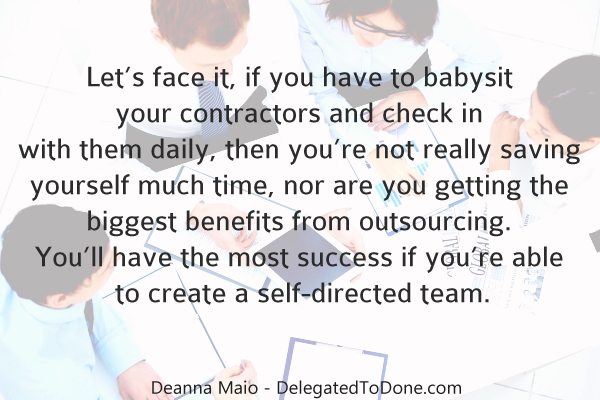Part of the power of having a team of outsourced professionals and contractors is to let go of tasks and the need to oversee everything. Let’s face it, if you have to babysit your contractors and check in with them daily, then you’re not really saving yourself much time, nor are you getting the biggest benefits from outsourcing. You’ll have the most success if you’re able to create a self-directed team.
What is a self-directed team?
It is a team of individuals that can take care of your projects and tasks with little involvement from you. You should be able to assign projects and tasks, and relax knowing that everything is going to be accomplished. Now this doesn’t magically happen. There are a few steps you’ll need to take.
- Have a vision. Know what you want from your team and what your ideal team looks like and how it functions. For example, will you have a project manager, a few writers and a virtual assistant? Will you simply have one dynamic assistant who can do everything? What do you want your team to look like?
- Identify your goals (long term and short term). What do you want your team to accomplish in the next few months and also in the next few years? How will they help you grow?
- Create measurements of success. How will you measure success for your team members and for your business goals? What systems will you use to measure success and how will you use them?
- Create systems to:
- Educate and train – You can use mind maps, training videos, and documents like checklists and templates.
- Communicate – How will you communicate with your team and how will they communicate with one another?
- Hold team members accountable – What systems will you use to hold your team members accountable and support their success? For example, will you pay bonuses or establish milestones?
- Give feedback. A self-directed team only works well if they know what they’re doing right and what they can improve on. Make sure part of your outsourcing plan includes a system or willingness to provide feedback to your team members.
- Assess success. What worked what didn’t? Take time at the end of each project or occasionally throughout the year to evaluate your contractors. Make sure your systems and your team are both functioning optimally.
- Reward success, educate and assess failures/mistakes. Once you’ve made the assessment of your systems, your contractors, and your team as a whole it’s time to take it to the next level. Help them succeed with rewards, education, and the opportunity to learn and grow.
A self-directed team makes your life much easier. You can trust that your team is there to succeed and to help your business grow and profit.
[Tweet “7 Steps to create a self-directed team of contractors so you can relax and grow your business confidently. https://www.delegatedtodone.com/how-to-create-a-self-directed-team”]
